
Hypena is a genus of moths in the family Erebidae. It was first described by Franz von Paula Schrank in 1802. These non-migratory moths overwinter as pupae and almost never come to bait as adults.

Hypena baltimoralis, the Baltimore bomolocha or Baltimore hypena, is a moth of the family Erebidae. The species was first described by Achille Guenée in 1854. It is found in the eastern part of the United States, west and south to Wisconsin, Missouri and Florida and Texas.
Hypena edictalis, the large bomolocha, is a moth of the family Erebidae. The species was first described by Francis Walker in 1859. It is found in North America from Quebec and Maine south to Virginia and Kentucky, west to the foothills of Alberta and the Peace River area of British Columbia.

Hypena palparia, the variegated snout-moth or mottled bomolocha, is a moth of the family Erebidae. The species was first described by Francis Walker in 1861. It is found in North America from Nova Scotia west across southern Canada to British Columbia, and south to Alabama and Texas.

Phalaenophana pyramusalis, the dark-banded owlet, is a moth of the family Erebidae. The species was first described by Francis Walker in 1859. It is found in North America from Saskatchewan to Nova Scotia, south to North Carolina and Texas.
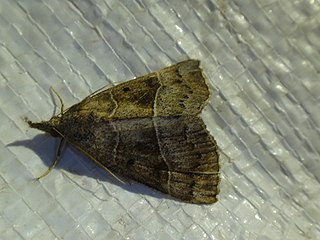
Hypena deceptalis, the deceptive hypena or deceptive bomolocha moth, is a moth of the family Erebidae. The species was first described by Francis Walker in 1859. It is found in North America from Manitoba to Quebec, south to Florida and Texas. It is absent from much of Gulf Coastal Plain though.
Hypena manalis, the flowing-line hypena, is a moth of the family Erebidae. It is found from Minnesota to Nova Scotia, south to Florida and Texas.

Hypena abalienalis, the white-lined hypena or white-lined bomolocha moth, is a moth of the family Erebidae. The species was first described by Francis Walker in 1859. It is found from southern Canada to northern Florida and Texas.
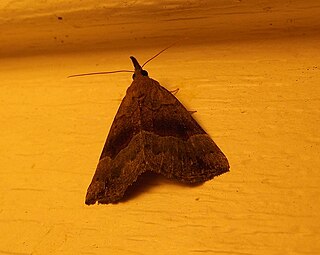
Hypena madefactalis, the gray-edged hypena or gray-eyed bomolocha, is a moth of the family Erebidae. The species was first described by Achille Guenée in 1854. It is found from extreme southern Canada (Quebec) to Georgia and Texas.
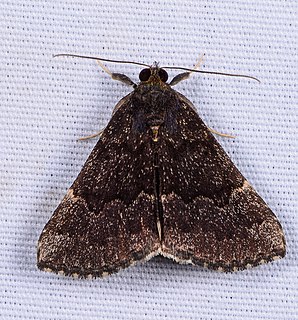
Hypena sordidula, the sordid hypena or sordid bomolocha moth, is a moth of the family Erebidae. The species was first described by Augustus Radcliffe Grote in 1872. It is found in North America from Quebec and Maine south to northern Florida and Texas, west to Louisiana and Kansas, north to Manitoba.

Hypena humuli, the hop looper or hop vine moth, is a moth of the family Erebidae. The species was first described by Thaddeus William Harris in 1841. It is found from coast to coast in Canada south in the east to Florida and Arkansas in the west to California. It is apparently absent from the south-central states. In Canada it is only absent from Newfoundland and Labrador, Prince Edward Island and the far north.
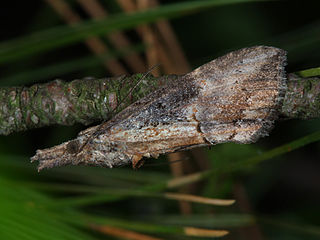
Hypena scabra, the green cloverworm or black snout, is a moth of the family Erebidae. The species was first described by Johan Christian Fabricius in 1798. It is found in North America from Canada south to Florida and Texas. It has also been reported from Great Britain.
Hypena eductalis, the red-footed bomolocha moth or alder smoke, is a moth of the family Noctuidae. The species was first described by Francis Walker in 1859. It is found in North America from Saskatchewan to Nova Scotia south to Florida and Texas.
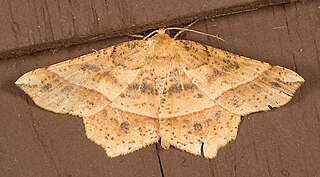
Euchlaena tigrinaria, the mottled euchlaena, is a moth of the family Geometridae. The species was first described by Achille Guenée in 1857. It is found from New Brunswick to Virginia, west to Texas, Utah and Oregon, north to British Columbia.
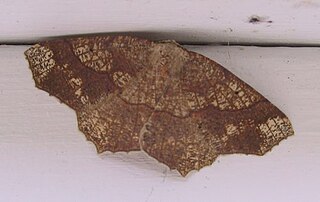
Besma quercivoraria, the oak besma, is a moth of the family Geometridae. The species was first described by Achille Guenée in 1857. It is found across southern Canada and all of the United States except California.
Lycia ursaria, the stout spanworm moth or bear, is a moth of the family Geometridae. The species was first described by Francis Walker in 1860. It is found in southern Canada and the northern United States, south to New Jersey and Iowa.

Hydrelia albifera, the fragile white carpet moth, is a moth in the family Geometridae. The species was first described by Francis Walker in 1866. It is found from Newfoundland to British Columbia, south in the east to the Gulf states. The habitat consists of deciduous and mixed-wood forests.

Hypena californica, known generally as the California cloverworm moth or western bomolocha, is a species of moth in the family Erebidae. It is found in North America, where it ranges along the Pacific Coast from Alaska to southern California. The habitat consists of moist forests and riparian areas.
Hypena umbralis, the banded bomolocha moth, is a species of moth in the family Erebidae.
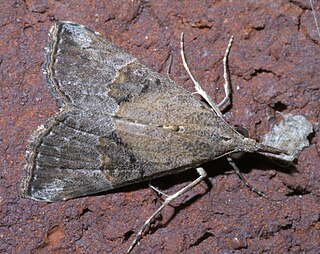
Hypena minualis, the sooty hypena or sooty bomolocha moth, is a moth in the family Erebidae. The species was first described by Achille Guenée in 1854. It is found in North America.















